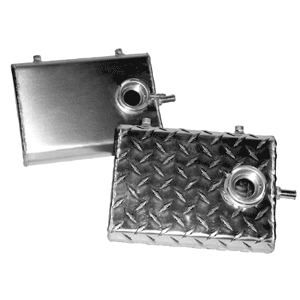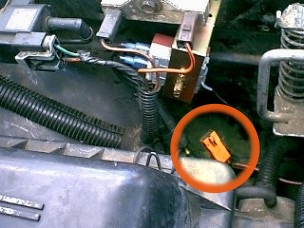When your Jeep overheats here are few quick things to check.
(It's the simple things that kill ya...)
- Look at the anti-freeze in your coolant bottle, filler neck or overflow (depending on what type system you have).
- Is the coolant level correct? Has it been leaking out or have ya had to add to it lately? If so... FIX THE LEAKS!
- Is it murky or clean looking? Is it oily? (If it's oily, ya better check for anti-freeze/water in your oil...)
- Run only a 50/50 anti-freeze and water mix! This is important for heat transfer... Believe it or not, pure anti-freeze will NOT cool as well as a 50/50 mix.
- Did you recently change anti freeze, or run low? You may have air trapped in the system. Fix that here.
- Is the serpentine belt in good condition and tight with no squealing or slipping? Check the idler pulley too!
- Does the water pump make noise? Does it leak or seep anti-freeze/water from the weep hole? Is it flowing properly?
- Check the lower radiator hose. It's supposed to have a spring inside it to keep it from collapsing when the engine is running. If someone changed the lower hose and didn't swap over the spring the hose can actually close shut. The faster the engine runs the harder the hose will clamp shut without this spring as the pump tries harder to pull water from the radiator.
- Have you tried a simple flush & refill? Prestone makes a good kit that ya can use for this. If you end up blowing a freeze plug, or radiator while flushing you can be sure it wasn't the kit... it was the scraps of rust that were still holding things together. Also, if someone has added any 'Radiator Sealant' or similar product, you may have a system that (in addition to masked leaks)... is clogged up with sealant preventing proper cooling.
- Has some idiot removed the thermostat? If so, ya can bet they had problems with the system and just delayed the inevitable by trying to keep the engine cooler this way. (Since yer here... "How'd taking the thermostat out work?") The 4.0L Jeep engine LIKES running at 210 degrees and the computer is designed to keep the engine functioning properly at this temperature.
- You do NOT need a 180 degree thermostat... see previous reasons. If your Jeep won't stay cool with the correct thermostat, and the thermostat is working properly... something else is wrong.
Here is an alternative to leaking / cracked OEM plastic tanks
& caps.
MacsRadiators.com has an ultra cool replacement tank that
will fix those two problems forever!
It's a bit pricey at $115.00 but if you
have a good radiator then this may be the solution for you!
No Gauges
Can't tell what temperature you're running? Do ya have "idiot lights" instead of gauges? For the early XJ's that is an easy one to swap in a factory instrument cluster from a donor vehicle although you could add aftermarket gauges if you can find a place to mount them (not so easy...).
Gauge Error
If your gauge isn't working properly, the first thing to check
is the temperature sender located on the rear driver side of the head.
If your gauge accurately shows the engine to be overheating
and the fan is NOT coming on then the problem can be in the auxilliary fan's
temperature sender (located in the driver side radiator tank of factory closed
systems), fan relay (near radiator on driver side fender well) or issues with
the wiring.
There is also a tiny orange fan diode
(below/beside air box) but this rarely gives any problem.
Check the clutch fan.
It's easy to overlook but a bad clutch fan will cause overheating in stop & go traffic, while you're idling or out on the trail at low speeds. When you rev the motor, you should be able to hear the clutch fan 'roar' up to speed slightly behind your engine speed. It's a noticeable sound when it's fixed, but ya don't pay any attention to it if it has slowly gone bad... other than wondering why you're overheating.
CHEAP "FIX" #1: If your clutch fan is known to be bad, you can remove it and drill two small holes in it where the internal spring is located and put two sheet metal screws in to make it 'lock up' all the time. Put these 180* apart, directly across from one another to keep things balanced. Upside: .20 cents to fix. Downside: Reduced gas milage with it going all the time.
CLUTCH FAN REPLACEMENT UPGRADE: Pull out the clutch fan and use it to enhance your garage wall. Instead of putting in another clutch fan, you can free up some horsepower when you install another electric fan for primary cooling like Dino did .
OEM Auxiliary Electric Cooling Fan
Located on driver side of radiator facing engine, the auxiliary electric fan is intended to supplement your clutch fan and provide additional cooling when engine temperature exceeds approximately 215* as well as anytime the air conditioner is on.
Does your OEM auxiliary electric fan come on when it should? Turn on the air conditioner and your electric fan should automatically come on. It also should come on when the temperature gauge gets somewhere around 215 or so. Diagnose Electric Cooling Fan Problems Here.
Note that the electric cooling fan is intended to HELP the main clutch fan and is not the primary fan but you can upgrade the auxiliary fan here.
You can check the fan's operation by unplugging the connector going to it from the wiring harness. Using a volt meter check to make sure that you have voltage getting to the fan. Do this with the
- ENGINE OFF (you don't need the motor running, in fact it's stupidly dangerous for this test).
- Turn key set 'ignition'. DO NOT START ENGINE! (You should hear the electric fuel pump and idiot lights should come on).
- Set air conditioner switch to 'on; position.
- Set your volt meter set to 20 volts dc..
- Make sure the negative volt meter lead is properly grounded.
- Touch the positive volt meter lead to the contacts in the connector leading to the harness.
One of these two wires should give you 12.5 or so volts dc.
Turn off ignition switch.
If you did not get any voltage to the electric fan with the air conditioner on, check your fuses first. You can get a simple fuse tester at any auto parts store, with a big assortment of fuses for around $10 but since ya have that fancy volt meter go ahead and check the air conditioner fuse. If it's ok, replace it anyhow and check the air conditioner relay by having a friend turn the a.c. off & on while you listen to, and watch the air conditioner clutch (located on the front of the air conditioner compressor where the belt goes over the a.c. pulley.) When the a.c. is switched on & off the clutch should engage & disengage with an audible click and the engine will noticably change speed each time. If the air conditioner clutch still won't engage/disengage when it's turned on/off you can try swapping in another air conditioner relay. Barring that, it's time to get that Factory Service Manual out and check the wiring circuit for shorts & open connections.
Upgrade option: If your wallet is full you can go to the dealer and get the higher powered MOPAR fan #52079444... or better yet, search through a junkyard and find one to replace the stock unit. Other ones may fit but you'll need to fab up brackets and shrouds. Be sure to check fit and get it mounted solidly! (Some boneyards have an inflated idea of what this thing is worth - I ended up buying a new aftermarket fan for less than half of the salvage yard price.)
'Burping' Air From Cooling System.
Electric Fan Aftermarket Thermostat / Control "How To".
Electric Fan Troubleshooting & Diagnosis
Auxiliary Electric Fan Aftermarket Replacement.
If you have pics of your own repairs or can suggest other methods - please contribute your ideas (and pictures) to this article!
|
|
|
Revised on:
January 9th, 2007 |